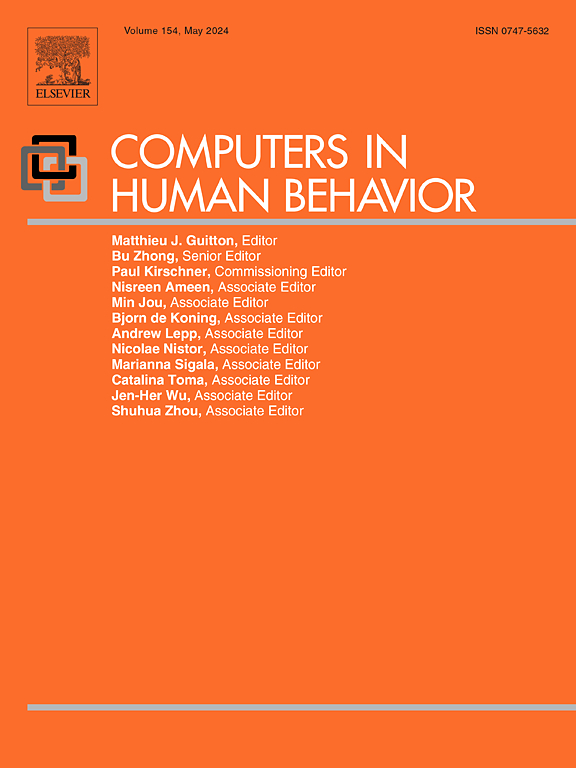Craving and attentional bias in gaming: Comparing esports, casual, and high-risk gamers using eye-tracking
IF 9
1区 心理学
Q1 PSYCHOLOGY, EXPERIMENTAL
引用次数: 0
Abstract
Attentional biases, as measured through eye movements, have been observed in both gaming disorders and substance addictions. However, few studies compare these biases among esports gamers (ESG), high-risk gamers (HRG), and other frequent gamers, despite ESG and HRG both groups dedicating significant time to gaming. This study included 47 male participants aged 15 to 19. Participants were categorized as ESG, casual gamers (CG), or HRG based on their MOBA experience, esports training, and Internet Gaming Disorder (IGD) scores. Each participant completed a dot-probe task with 56 stimulus conditions based on gaming cues, while eye-tracking technology recorded eye movements. The results indicated that HRG spent more total viewing time on stimulus images than ESG and CG. Additionally, HRG had longer first fixation durations and fewer saccade counts than the other two groups. Furthermore, HRG reported higher impulsivity and lower attentional focusing, suggesting a distinct psychological profile. Although ESG did not exhibit the same attentional biases as HRG, their self-reported gaming time was similar. This may be due to gaming being a career commitment for ESG, while for HRG, it serves as an escape from life pressures. Notably, eye-movement measures can identify high-risk tendencies early and uncover differences missed by self-report scales, including saccade count and attentional shifting. Caution is needed when diagnosing gaming disorder solely based on gaming time and self-reports. Future research could use attentional bias tasks as complementary diagnostic tools and further explore higher depression levels in HRG and ESG compared to CG.
游戏中的渴望和注意力偏差:比较使用眼球追踪的电子竞技、休闲和高风险玩家
通过眼球运动来衡量的注意力偏差,在游戏障碍和物质成瘾中都有观察到。然而,很少有研究比较电子竞技玩家(ESG)、高风险玩家(HRG)和其他频繁玩家之间的这种偏见,尽管ESG和HRG都在游戏中投入了大量时间。这项研究包括47名15至19岁的男性参与者。参与者根据他们的MOBA体验、电子竞技训练和网络游戏障碍(IGD)分数被分为ESG、休闲游戏玩家(CG)或HRG。每个参与者都完成了一项基于游戏线索的56种刺激条件下的点探测任务,同时眼球追踪技术记录了他们的眼球运动。结果表明,HRG组在刺激图像上花费的总观看时间比ESG组和CG组多。此外,与其他两组相比,HRG组的首次注视时间更长,眼跳计数更少。此外,HRG报告了更高的冲动性和更低的注意力集中,这表明了一种独特的心理特征。尽管ESG并未表现出与HRG相同的注意力偏差,但他们自我报告的游戏时间是相似的。这可能是因为对于ESG来说,游戏是一种职业承诺,而对于HRG来说,它是一种逃避生活压力的方式。值得注意的是,眼动测量可以早期识别高风险倾向,并揭示自我报告量表遗漏的差异,包括扫视计数和注意力转移。在仅仅根据游戏时间和自我报告来诊断游戏障碍时,需要谨慎。未来的研究可以使用注意偏倚任务作为补充诊断工具,并进一步探索HRG和ESG与CG相比更高的抑郁水平。
本文章由计算机程序翻译,如有差异,请以英文原文为准。
求助全文
约1分钟内获得全文
求助全文
来源期刊

Computers in Human Behavior
Multiple-
CiteScore
19.10
自引率
4.00%
发文量
381
审稿时长
40 days
期刊介绍:
Computers in Human Behavior is a scholarly journal that explores the psychological aspects of computer use. It covers original theoretical works, research reports, literature reviews, and software and book reviews. The journal examines both the use of computers in psychology, psychiatry, and related fields, and the psychological impact of computer use on individuals, groups, and society. Articles discuss topics such as professional practice, training, research, human development, learning, cognition, personality, and social interactions. It focuses on human interactions with computers, considering the computer as a medium through which human behaviors are shaped and expressed. Professionals interested in the psychological aspects of computer use will find this journal valuable, even with limited knowledge of computers.
 求助内容:
求助内容: 应助结果提醒方式:
应助结果提醒方式:


